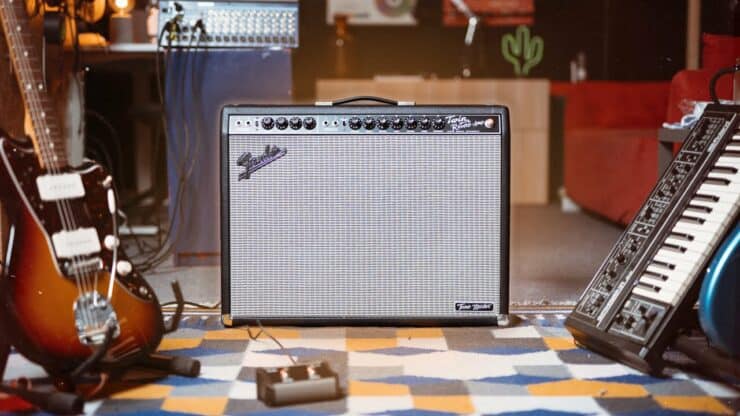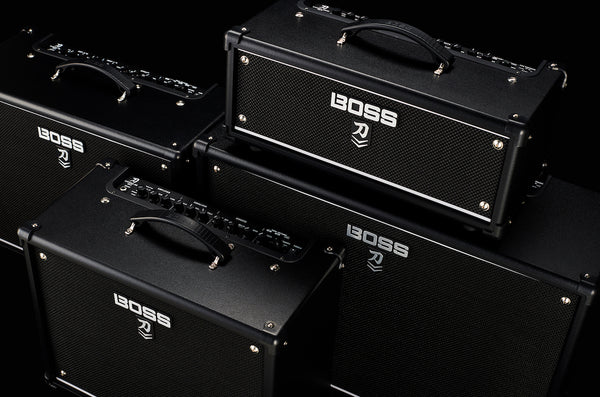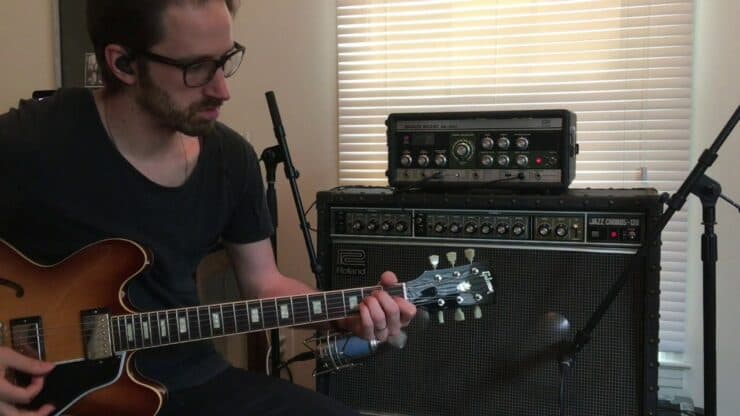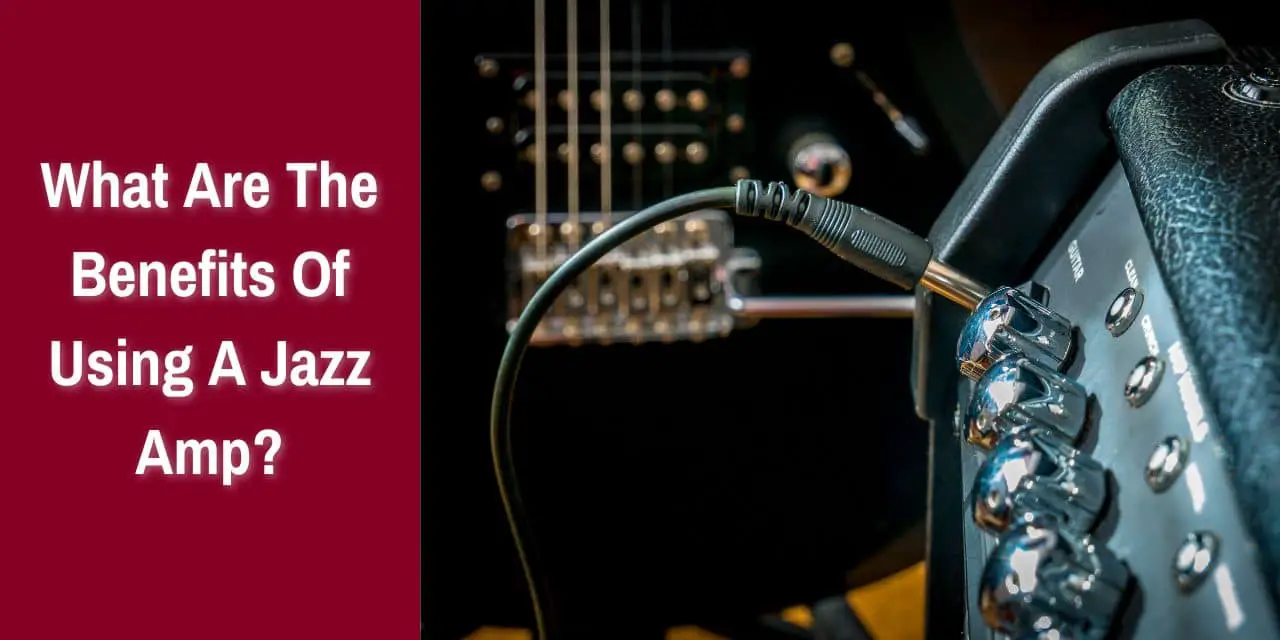Guitar players, if you’re looking for a new way to add some spice to your sound, you should consider incorporating a jazz amp into your set up. With the right jazz amp, you’ll be able to explore a whole new range of tonal possibilities, allowing you to create a truly unique sound. In this article, we’ll take a look at the benefits of using a jazz amp and how you can use it to enhance your sound. So, if you’re curious to learn more, read on!
What is a jazz amp?
A jazz amp is an amplifier designed specifically to complement the nuances and subtleties of jazz music. While many genres tend to rely on aggressive tones and powerful distortion, jazz amps prefer taking a different approach. These amps prioritize clean, transparent tones with an emphasis on warm midrange frequencies, which allows the inherent qualities of instruments, like guitars and keyboards, to shine through without excessive coloration. These amps focus on accuracy, clarity, and sonic precision to capture the intricate details of each note and chord.
>>> Click here to read our review about the Top 15 Best Jazz Amps <<<
The working behind a jazz amp involves a number of key components and features that collaborate to create the signature tones associated with this genre. These amps are designed to produce clean, undistorted tones. This clear sonic canvas offers a platform for the intricacies of jazz improvisation to be heard distinctly.
Many jazz amps incorporate vacuum tubes or valves in their circuitry. These tubes impart a warm, organic, and slightly compressed sound to the signal, enhancing the harmonics and contributing to the vintage jazz aesthetic. They feature lower to medium power outputs compared to high-gain rock or metal amps. This power range allows for a smooth breakup when pushed, which results in a musical and controlled distortion that suits jazz playing.
Jazz amps feature EQ controls that allow musicians and guitarists to finely tailor their sound. The emphasis is often on the midrange frequencies, which allows instruments like guitar and brass to cut through the mix with clarity. Built-in reverb and tremolo effects are common in jazz amps. Reverb adds a sense of space and dimension to the sound whereas tremolo imparts rhythmic modulation, adding a subtle movement to the performance.
Moreover, these amps often come with high input sensitivity, allowing them to respond dynamically to the player’s touch and nuances. Jazz amps might incorporate specific speaker configurations, such as 10-inch or 12-inch speakers that enhance midrange presence and projection. They are typically designed with portability in mind. They often come with compact sizes and stylish aesthetics that align with the classic jazz era.
What are the benefits of using a jazz amp?
Jazz music thrives on subtlety, nuance, and the intimate interaction between the musician and their instruments. This is why jazz music demands amplification that can capture these unique nuances and subtleties. To capture the essence of jazz’s intricate melodies and improvisational brilliance, a jazz amp will come in handy. As a beginner, you might wonder are these amps really that special? What are the benefits of using a jazz amp? Jazz amps are specifically designed to complement the genre’s unique characteristics, offering a wide range of benefits that elevate the musical experience for both players and audiences alike. Here are some of the benefits of using a jazz amp and how they contribute to the artistry of jazz performances.

#1. Cleaner sound
One of the major benefits of using jazz amps is the cleaner sound they offer. Jazz amps are meticulously designed to deliver pristine tones, free from unwanted distortion or overdrive. This clean sonic foundation ensures that the inherent qualities of the instruments like the warmth of a hollow-body guitar or the resonant tones of a saxophone are faithfully reproduced. Using a jazz amp, jazz musicians can easily convey their musical intentions with clarity and precision, allowing every note to shine with its full character.
#2. More headroom
Headroom refers to the available power that an amp can deliver before distorting. Jazz amps are engineered to provide ample headroom, allowing the musician to play at higher volumes without causing the amp to break up into distortion.
This characteristic is important for jazz performances, where nuances and expressive dynamics play a key role. More headroom will allow musicians to achieve a wide range of volume levels while still maintaining the clarity and cleanliness of the sound, enhancing the subtlety of their musical expressions.
#3. Better dynamics
Jazz music is renowned for its dynamic contrasts, soft whispers followed by crescendos of intensity. Jazz amps excel in providing these expressive dynamics. The clean sound and higher headroom of jazz amps allow players to achieve a wide dynamic range, from delicate pianissimos to powerful fortissimos. This control over dynamics enhances the emotional impact of the music, drawing the audience into the artist’s journey of sound.
#4. Greater tonal flexibility
Jazz amps are designed with a focus on tonal flexibility. This allows musicians and guitarist to sculpt their sound to suit a wide variety of musical contexts. The onboard EQ controls of jazz amps allow precise adjustments to frequencies, allowing players to tailor their tone to complement different instruments, playing styles, and ensemble arrangements. This versatility empowers jazz musicians to explore different tonal palettes and adapt to diverse musical settings, from intimate trios to larger big bands.
#5. Sonic transparency
Another big benefit of jazz amps is that they’re engineered to reproduce the unique timbre of each instrument, preserving the authenticity of the musician’s sound. This transparency ensures that the tonal qualities of a jazz guitarist’s archtop guitar, a pianist’s grand piano, or a brass player’s trumpet are conveyed accurately through the amp. Jazz amps don’t color the sound with unnecessary coloration, allowing the natural character of each instrument to shine through.
#6. Warmth and harmonic richness
Many jazz amps make use of vacuum tube technology, which imparts a warm, harmonically rich sound to the signal. This characteristic is especially appealing for jazz musicians and guitarists who aim to recreate the vintage elegance and charm of classic jazz recordings. The harmonics produced by tube amps add depth and character to the sound, contributing to the captivating allure of jazz music.
#7. Smooth breakup and dynamics
Jazz amps often feature a lower to medium power range, which allows for controlled breakup when pushed to higher volumes. This controlled distortion adds a layer of expressive dynamics to the performances. Jazz players can utilize the amp’s responsiveness to their touch, achieving varying levels of overdrive to match the mood and intensity of their improvisations.
#8. Versatility for instruments
While primarily associated with guitars, jazz amps are versatile enough that they can accommodate a wide range of instruments commonly found in jazz ensembles, such as saxophones, keyboards, and upright basses. This adaptability allows different instruments to retain their unique sonic qualities while benefiting from the jazz amp’s tonal characteristics and clarity.
#9. Ideal for small venues
Jazz amps are well-suited for intimate settings and smaller venues. Their compact size and portability make them convenient for jazz players who frequently perform in cozy jazz clubs, cafés, or private gatherings. These guitar amps offer an immersive listening experience for both musicians and audiences in intimate spaces.

#10. Classic aesthetics
Jazz amps often embrace classic aesthetics that harken back to the golden era of jazz music. Vintage-inspired designs, timeless finishes, and meticulous craftsmanship contribute to the overall visual appeal of the jazz amp. All these align with the genre’s nostalgic and timeless atmosphere.
Different types of jazz amps
Choosing the right amp is a vital decision for jazz musicians and guitarists looking to translate their musical expressions into captivating tones. Jazz music’s intricate melodies and nuances demand an amp that is capable of faithfully reproducing its subtleties. Luckily, there are many different types of amps available, each offering unique characteristics that cater to the diverse needs and preferences of jazz musicians. Here are the different types of jazz amps that you can go for.
Tube amps
Tube amps or valve amps are known for their warm and harmonically rich tones. Using vacuum tubes to amplify the signal, these amps are capable of producing a sound that is often associated with the vintage allure of jazz music.
These guitar amps excel in capturing the dynamic nuances and intricate details of jazz guitar playing, offering a natural compression and sustain that complements the genre’s expressive phrasing. The mid-range focused tone of tube amps cuts through the mix, allowing the subtleties of jazz improvisation to shine through. These amps are favored by musicians and guitarists looking for a classic organic sound with a smooth breakup when pushed, making them an extremely popular choice for traditional jazz styles.
Solid-state amps
Solid-state amps employ transistors and integrated circuits for amplifying the signal. Known for their clean and transparent sound, solid-state amps offer precision and accuracy that suit the clarity needed in jazz playing.
Solid-state amps excel at producing the subtle articulation and clean tones important for jazz music. These amps deliver exceptional note definition and a balanced tonal response across the frequency spectrum. Musicians and guitarists who prioritize sonic accuracy and require a reliable, consistent sound often opt for solid-state amps, especially for a modern jazz fusion or when playing with larger ensembles.
Digital modeling amps
Digital modeling amps make use of advanced digital technology for replicating the sounds of various amps and effects. These amps offer unparalleled versatility, allowing jazz musicians and guitarists to experiment with a wide range of amp models, tones, and effects. Digital modeling amps come equipped with numerous presets that can be tailored to suit different jazz styles, from traditional to contemporary.
This flexibility is perfect for musicians who want to explore different tonal palettes and effects without investing in multiple physical amps. Digital modeling amps are especially useful for jazz musicians who perform a diverse repertoire and want to adapt their sound to different musical contexts.
Hybrid amps
Hybrid amps combine the characteristics of tube amps and solid-state amps, creating a versatile sonic palette that appeals to jazz musicians looking for a balanced approach. These amps often feature a tube preamp section that imparts warmth and harmonically rich tones, paired with a solid-state power amp for stability and headroom.
Hybrid amps are perfect for jazz musicians and guitarists who appreciate the vintage warmth of tubes that require the reliability and consistent performance of solid-state components. This fusion of technologies offers tonal flexibility, making hybrid amps suited for different jazz styles.
Acoustic amps
Acoustic amps are designed to amplify acoustic instruments like acoustic guitars, saxophones, and jazz upright basses. While not used exclusively for jazz, acoustic amps excel in preserving the authentic tonal qualities of acoustic instruments. This makes them such a great choice for jazz musicians who incorporate acoustic elements into their performances.
These amps emphasize sonic clarity and transparency, allowing jazz musicians and guitarists to showcase the natural timbre and dynamics of their instruments without compromising their authenticity.
Boutique amps
Boutique amps are handcrafted amps that are popular for their meticulous construction, attention to detail, and unique tonal characteristics. Produced in limited quantities by skilled artisans, boutique amps offer a personalized touch that appeals to jazz musicians looking for a distinct sonic identity.
These jazz amps often use high-quality components and innovative designs to deliver rich, expressive tones that stand out in a crowded amplification landscape. Boutique amps cater to musicians and guitarists who value craftsmanship, individuality, and a personalized approach to sound shaping.

How to choose the perfect jazz amp?
Selecting the perfect jazz amp for your needs is an important step in shaping your musical identity as a jazz musician. Jazz music’s intricate melodies and nuanced improvisation demand an amp capable of capturing its subtleties and delivering a clean, warm, and dynamic sound. With a wide variety of options available, choosing a jazz amp can be an exciting yet challenging endeavor. Here are a few tips on how you can choose the perfect jazz amp that aligns with your playing style, preferences, and artistic inspirations.
#1. Determine your playing style and needs
Before start scouring your way through a variety of jazz amps, you need to take a moment or two to assess your playing style, musical preferences, and performance needs. Are you a solo performer or are you a part of a jazz ensemble? Do you focus on traditional jazz standards or explore more modern jazz fusion? You must understand your playing style and needs as it’ll help you narrow down the features and characteristics you need in a jazz amp.
Choose the amp technology that suits your tonal preferences. Tube amps are generally known for their warm, harmonically rich tones and dynamic responses. Meanwhile, solid-state amps offer clean and transparent sounds, which are perfect for musicians and guitarists who prioritize accuracy. Hybrid amps tend to combine the best of both worlds, featuring a tube preamp for warmth and a solid-state power amp for stability.
#2. Power rating
Power rating refers to the amp’s output wattage, which determines how loud the amp can go before distorting. For jazz music, where cleaner tones and dynamic contracts are vital, a moderate power rating is often preferred. Lower wattage amps (around 15 to 30 watts) allow for earlier breakups as they offer subtle overdrive at lower volumes. If you’re playing in larger venues, a higher wattage (50 watts or higher) will provide enough headroom for maintaining a clean tone even at higher volumes.
#3. Size of the speaker
The size of the speaker in your jazz amp will significantly affect the amp’s overall tone and projection. Smaller speakers (10 inches or less) offer tighter and more focused midrange tones. This is ideal for smaller spaces or solo performances. Meanwhile, larger speakers (12 inches or more) offer a more low-end response and a broader frequency range, which makes them suitable for larger venues or ensemble playing. You must consider the context of your performance before deciding on the speaker size.
#4. Tone controls
Tone controls on a jazz amp, including bass, midrange, and treble adjustments, are important for tailoring your sound to your preferences and the musical context. A well-designed EQ section will allow you to emphasize the midrange frequencies that are characteristic of jazz tones. You should look for jazz amps with responsive tone controls that allow precise shaping of your sound without sacrificing clarity or transparency.
#5. Effects
While jazz tones often lean toward cleaner sounds, some effects can add subtle enhancements to your sound. The built-in reverb is a common feature in jazz amps as it adds a touch of ambiance to your playing. Some jazz amps also offer effects like tremolo, delay, or chorus, which can be used tastefully to add depth and texture to your performance without overwhelming the inherent beauty of jazz music.
#6. Connectivity options
You should also consider the connectivity options that the jazz amp offers. Having multiple inputs will allow you to connect different instruments or external devices, such as microphones or keyboards. Look for jazz amps with headphone outputs for silent practice or recording. Moreover, amps with line outputs or direct recording outputs are useful for connecting to PA systems or recording equipment.
#7. Portability and size
Depending on your performance requirements, you should consider the jazz amp’s portability and size. Combo amps, which integrate the amp and speaker in one unit, tend to be convenient for smaller gigs and practice. However, if you frequently play in larger venues, you may have to opt for a separate head and cabinet setup for more flexibility in speaker placement and sound distribution.
#8. Stick to the budget
Set a budget that reflects the quality and features you need in a jazz amp and stick to it. While boutique amps can offer exceptional craftsmanship and tonal characteristics, there are many excellent mid-range options that provide the necessary qualities for jazz playing without breaking the bank.
#9. Read reviews but trust your ears
You need to research online, read reviews, and seek recommendations from fellow jazz musicians. Hearing about the experience of other people with specific jazz amps can provide valuable insights into their performance, reliability, and suitability for jazz music.
But ultimately, the most important factor for choosing a jazz amp would be how it sounds to your ears. Play your instrument through the amp and trust your intuition. The amp that resonates with you and enhances your playing style would be the best choice for your musical journey.
FAQs
What are the benefits of using a jazz amp?
Jazz amps are designed to provide clean and warm tones, making them ideal for jazz and other styles of music that require clear, articulate sound. Jazz amps typically have low wattage and small speaker sizes, which allows them to provide a wide range of tones without sacrificing portability. They also often have features such as reverb and tremolo which can add depth and texture to your sound.
What type of amp should I use if I want to play jazz?
If you want to play jazz, it is best to use a jazz amp. Jazz amps provide the clean and warm tones that are essential for jazz, as well as features such as reverb and tremolo to add texture to your sound. They are also typically portable, making them ideal for practice and performance.
How do jazz amps compare to regular amplifiers?
Jazz amps and regular amplifiers differ in several ways, including wattage, speaker size, tone, and features. Jazz amps typically have lower wattage and smaller speakers than regular amplifiers, making them more suitable for practice and smaller venues. They also often provide cleaner and warmer tones than regular amplifiers, as well as features such as reverb and tremolo.



